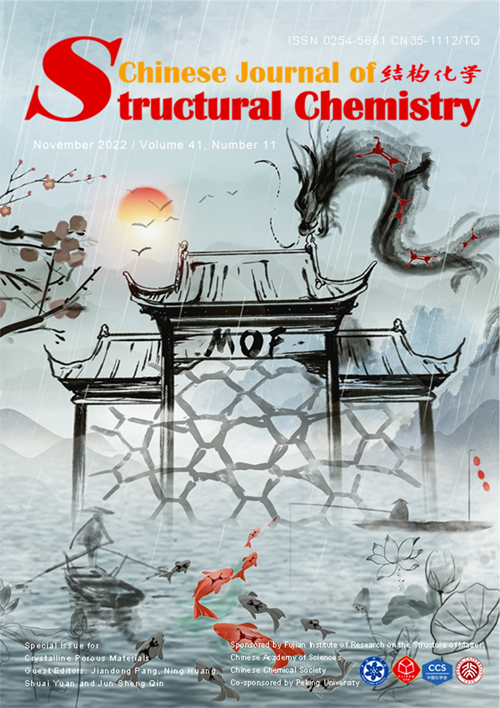
Cover Picture
Recent Advances in C2 Gases Separation and Purification by Metal-Organic
Frameworks
Zhengyi Di, Xinjing Zheng, Yu Qi, Heng Yuan and Cheng-Peng Li*
Submit a ManuscriptPreface to Crystalline Porous Materials
Jiandong Pang*, Ning Huang*, Shuai Yuan* and Jun-Sheng Qin*
Chin. J. Struct. Chem. 2022, 41, 2211001-2211002
October 31, 2022
Crystalline Porous Materials
ABSTRACT
Novel crystalline porous materials refer to porous materials constructed by linking organic molecule units with coordination bonds, covalent bonds, or supramolecular interactions, mainly including metal-organic frameworks (MOFs), covalent organic frameworks (COFs), metal organic cages (MOCs), and so on. Due to their predictable and designable long-range ordered structures, high surface areas, guest-accessible voids, and easily functionalized channels by pre- or post-modifications, novel crystalline porous materials have attracted much attention in the past two decades, which show potential applications in light emission, gas adsorption and separation, heterogeneous catalysis, and sensing. Recently, many efforts have been made to exploit novel crystalline porous materials with excellent properties, and various improvements and investigations are still highly required for the further development of this field.
The special issue “Crystalline Porous Materials” comprises a collection of original research and review articles on the synthesis, structure, and applications of novel crystalline porous materials. This special issue consists of seven reviews and one research article, reflecting recent developments on MOFs, COFs, and MOCs. The collected papers cover the broad applications of crystalline porous materials in the fields of gas separation, photocatalysis, electrocatalysis, sensing, and ion conduction. A brief summary of all papers in this issue is as follows.
First, in “A Water-Stable 3D Eu(III)-Organic Framework as a Bi-Functional Ratiometric Luminescent Sensor for Fast, Sensitive and Selective Detection of ODZ and Hg2+ in Aqueous Media”, a new luminescent Eu(III)-based MOF was designedly synthesized with an electron-rich π-conjugated organic linker, which shows good water stability and can be used for the efficient detection of ornidazole and Hg2+ in aqueous solution.
The paper “Lithium Ion Conduction in Covalent Organic Frameworks” focused on the emerging developments of Li+ conduction in COFs. The structures and properties of the Li+ conduction COFs were summarized in the past years, the structure-property relationships were elucidated, and the remaining challenges as well as future research directions in the COF-based lithium conductive area were also provided.
The paper “A Review on
the Progress of Metal-Organic Frameworks in Electro-chemiluminescence Sensors”
reviewed the recent progress of MOFs applied to
electrochemiluminescence (ECL) for the sensing of metal ions, nucleic acids,
proteins, bacteria, viruses, and other human health-related targets. The
correlations between MOF structures and ECL properties were discussed, and
potential opportunities and challenges for MOFs used for ECL sensing were also
explored.
The paper “Recent
Advances in C2 Gases Separation and Purification by Metal-Organic
Frameworks” emphasized on recent advances for MOFs applied to C2 gases (mainly including acetylene/ethylene, ethane/ethylene, and
acetylene/carbon dioxide) separation and purification. The structure-related
separation mechanism of MOFs, future challenges faced by the field, and possible
research directions were also discussed.
In “Recent Progresses in Lanthanide Metal-Organic Frameworks (Ln-MOFs) as Chemical Sensors for Ions, Antibiotics and Amino Acids”, some representative research results reported in the past five years on lanthanide-based MOFs were introduced. The chemical sensing of Ln-MOFs on ions, antibiotics, and amino acids based on luminescent quenching or enhancing effects were carefully classified, and future research directions were also proposed.
The paper “A Review on Crystalline Porous MOFs Materials in Photocatalytic Transformations of Organic Compounds in Recent Three Years” summarized the recent research progress of MOFs for photocatalytic organic transformations. The preparation and synthesis strategies of MOF-based photocatalysts, the application of these photocatalysts on diverse types of organic transformation reactions, and the development opportunities and challenges in this field were all discussed in turn.
In “Recent Progress in Covalent Organic Frameworks (COFs) for Electrocatalysis”, COF-based electrocatalysts used for hydrogen evolution reaction (HER), hydrogen oxidation reaction (HOR), oxygen evolution reaction (OER), oxygen reduction reaction (ORR), nitrogen reduction reaction (NRR) and carbon dioxide reduction reaction (CO2RR) were well summarized. The design strategies of COF-based electrocatalysts, recent progress of COF-derived catalysts for specific electrocatalytic reactions, and future research directions/challenges were carefully discussed.
Finally, in “Recent Advances in Metal-Organic Cages-Based Composite Membranes”, recent research advances of MOCs applied to membrane separation, including synthetic artificial channels, reverse osmosis, nanofiltration, pervaporation and gas separation, were carefully reviewed. Representative MOCs used for composite membrane fabrication were highlighted, while potential research directions and challenges were also deeply discussed.





